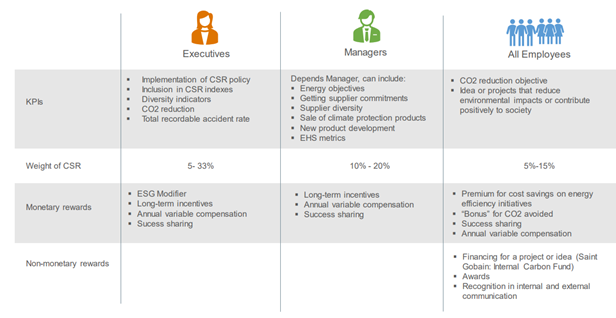Employee engagement is crucial for achieving a company’s CSR objectives, particularly those related to Sustainability. When employees actively participate in sustainability initiatives, the company progresses faster towards its environmental and social goals.
This article explores how companies can integrate CSR objectives, also known as CSR KPIs (Key Performance Indicators), into employee objectives to foster a culture of sustainability and drive meaningful change.
Table of Contents

Linking CSR Objectives to employee performance
Linking CSR objectives to employee objectives strengthens accountability and assigns responsibility to individuals for their contribution to the company’s sustainability performance. This fosters a sense of ownership and motivates employees to actively engage in sustainable practices.
However, implementing this strategy effectively requires careful consideration of several factors:
Role Diversity: Different roles within the company contribute to sustainability in various ways. Identifying relevant KPIs for each role ensures a fair and achievable set of objectives.
Identifying KPIs: Choosing the right KPIs plays a crucial role. These metrics should be clear, measurable, and directly linked to the employee’s specific role and the company’s overall sustainability goals.
Resource Allocation: Successfully integrating CSR objectives into employee performance management might require additional resources to support implementation and track progress.
Examples of CSR Objectives in employee performance
Our research, which included reviewing Universal Registration Documents, Carbon Disclosure Project questionnaires, and discussions with members of our Sustainable Business Community (SBC), revealed various examples of CSR objectives integrated into employee performance and the incentives offered by companies. These are summarized in the table below:

Cascading Objectives and Incentives
Our research observed that companies often cascade CSR objectives across three employee levels: executives, managers, and all employees. Safety and CO2 performance indicators are commonly evaluated at all levels, likely due to their collective impact and the availability of clear tracking mechanisms.
Regarding incentives, monetary rewards are more prevalent for executives and managers. For all employees, incentives usually take the form of short-term bonuses, recognition on company platforms, or awards. Some companies even offer a combination of both monetary and non-monetary rewards. Ultimately, the most important factor is fostering employee fulfillment in contributing to the company’s sustainability goals.
Integrating CSR objectives into employee performance management presents a powerful opportunity to empower employees, drive a culture of sustainability within the company, and ultimately achieve greater progress towards corporate social responsibility goals. By carefully considering role diversity, selecting relevant KPIs, and offering appropriate incentives, companies can create a win-win situation for both employees and the environment.
If you want to optimize your CSR strategy, join the SBC benchmarking community: the community that brings together professionals working in the field of Sustainable Development and CSR to progress together on common challenges.



